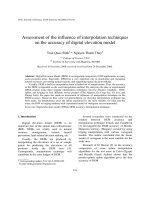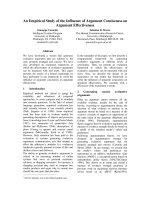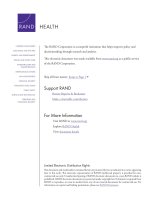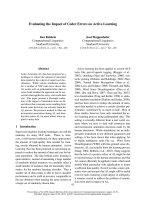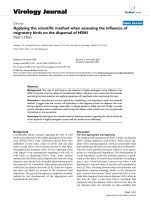Evaluating the influence of cutting parameters on part’s accuracy and grinding wheel’s wear in grinding profile for ball bearing’s inner ring groove
Bạn đang xem bản rút gọn của tài liệu. Xem và tải ngay bản đầy đủ của tài liệu tại đây (500.43 KB, 13 trang )
Vietnam Journal of Science and Technology 56 (4) (2018)
DOI: 10.15625/2525-2518/56/4/10892
EVALUATING THE INFLUENCE OF CUTTING PARAMETERS ON
PART’S ACCURACY AND GRINDING WHEEL’S WEAR IN
GRINDING PROFILE FOR BALL BEARING’S INNER RING GROOVE
Nguyen Anh Tuan1, *, Vu Toan Thang2, Nguyen Viet Tiep2
1
University of Economic and Technical Industries, 456 Minh Khai, Hai Ba Trung, Ha Noi
2
Hanoi University of Science and Technology, 1 Dai Co Viet, Hai Ba Trung, Ha Noi
*
Email:
Received: 14 November 2017; Accepted for publication: 5 July 2018
Abstract. This paper presents some research results to determine the impact of grinding
parameters on grinding wheel’s wear and part’s accuracy in grinding profile for ball bearing's inner
ring groove. Firstly, the distribution diagrams of part’s tolerance zone and grinding wheel’s wear at
different cutting conditions has been used to determine important outputs in the profile grinding
process for the inner ring groove of the ball bearing. Based on that, the experimental regression
functions that express the dependencies of the important outputs (grindstone wear Hzi, surface
roughness Ra, oval Op) on the technical parameters (normal feed rate Fn, speed of part Vp, depth of
cutting t and the number of part in a grinding cycle Np) are determined by the least squares
experimental planning method. From those mathematical functions, the effect of grinding
parameters on the grinding wheel’s wear and part’s accuracy in profile grinding for the inner ring
groove is evaluated.
Keywords: Profile grinding, surface roughness, cutting parameters.
Classification numbers: 5.1.1, 5.1.3.
1. INTRODUCTION
Grinding is a popular finish processing method. During the process, the accuracy of part, the
durability of grinding wheel as well as the productivity of the process is highly dependent on the
parameters of the cutting mode [1]. Thus, one of the most important points to achieve the
technical and economic efficiency of grinding process is to evaluate the influence of input factors
on the change of output factors. Then, the output factors will be controlled as requirement.
Among the output factors that need to be controlled, the part’s accuracy is the most important
factor, especially for bearing items (roller bearing) [2]. In term of structure, the roller bearing
consists of four parts: outer ring, inner ring, roller and cage as the Figure 1 [3, 4]. For the inner and
outer ring parts of the bearing, the groove surface is the most important. The profile grinding
currently is one of the most popular machining methods applied to assure the accuracy of the
groove surface.
Vietnam Journal of Science and Technology 56 (4) (2018)
DOI: 10.15625/2525-2518/56/4/10892
Figure 1. Structure of roller [3, 4].
However, the previous researches have studied primarily on the influence of cutting
parameters on part’s surface roughness under surface grinding or cylindrical grinding [5, 6]. The
influence of technical parameters on part’s accuracy under profile grinding for the inner ring
groove of the 6208 ball bearing has not been considered deeply.
In this paper, the profile grinding operation for the inner ring groove of the 6208 ball
bearing was studied. Thus, the theoretical background was analyzed to assure the accuracy in
profile grinding for the inner ring groove. At the same time, experiments were conducted to
evaluate the influence of grinding parameters on the accuracy of the parts as well as the wear of
grinding wheel.
2. RESEARCH CONTENT
2.1. Theoretical basis to assure processing accuracy in profile grinding for the inner ring
groove of ball bearing
For processing the groove surface, it requires not only dimension accuracy for groove
bottom’s diameter, groove’s radius and distance from groove central line to head surface, but also
the accuracy for correlative positions including the oval of groove bottom’s diameter, the circular
run-out of the groove central line in comparison to the head surface. Especially, the surface
roughness of groove must be smaller 0.5 µm (Ra < 0.5 µm) [7]. These technical requirements of
the finish grinding operation for the 6208 ball bearing’s inner ring groove are shown as Figure 2.
9±0.025
R6,17+0.05
Ø48±0.01
0.008 A
0.003
0.5
Figure 2. Drawing shows the technical requirements of the finish grinding operation for the groove
of the 6208 ball bearing’s inner ring [7].
Evaluating the influence of cutting parameters on part’s accuracy and grinding wheel’s wear …
However, the important issue is to find out a solution to assure the part’s accuracy during
the process. The processing standard errors and cause of these standard errors are necessary to
be determined to reduce them. Thus, the following solutions would be applied to assure the
accuracy in dimension and correlative position as well as surface roughness of the inner ring
groove:
- The groove surface would be lathed before grinding by hard turning method on CNC
machine. This decreases surplus stock, increases productivity for groove grinding and decreases
the press error causing by bending deform occurring from previous heat treatment. During the
grinding process, the errors in the geometry of the work-piece cause the same type of errors in
the part such as oval, cone, circular run-out, etc. [2]. If material hardness and surplus stock are
inhomogeneous, the errors in the geometry of part will happen. It is necessary to lathe the
surface of groove before grinding.
- Applying the profile grinding principle and using 3MK136B profile grinder to process the
groove surface. The Figure 3 presents the principle diagram of grinding profile for the inner ring
groove of ball bearing with grinder 3MK136B.
nw
Grinding wheel
4
e
np
Work-piece
Work-piece
holder
3
2
1
3
2
sn
5
Fn
Figure 3. Diagram of profile grinding principle for the groove of the ball bearing’s inner ring [7]
1, 2: Work-piece holder; 3: Magnetic pole; 4: Grinding wheel; 5: Grinding work-piece.
In this method, the profile of processing surface and working surface of grinding wheel are
coincided. Grinding process is proceeded by normal motion of machine (rotation motion of
work-piece np, rotation motion of grinding wheel (nw) and normal feed motion of workbench Fn).
Especially, rough grinding mode, finishing grinding mode and grinding mode without spark
are implemented in the same process to improve productivity and ensure the part’s accuracy.
The normal motion process of the worktable for grinding one product is shown in Figure 4. It
is divided into the following stages: 1. The workbench turns rapidly; 2. The workbench
approaches forward; 3. The workbench performs a normal motion for the rough grinding; 4.
The machine grinds without normal feed motion in a period of 1 ÷ 2 seconds to rough bound;
5. The workbench performs a normal motion for the fine grinding; 6. The machine grinds
without normal feed motion in a period of 1 ÷ 2 seconds to fine bound. This is fine grinding
period to grind without spark. It helps to increase the polish and accuracy of the part; 7. The
workbench turns back rapidly and returns its origin position; 8. Swing arm of grinder
loads/unloads automatically.
3
Nguyen Toan Thang, et al.
Displacement
distance of
workbench
Normal cycle of grinding
Annotation
Megnetic coil
Mechanical
arm
Feed step
motor
Demagnetization
Magnetization
Grasp head in Swing arm load/unload
Compensation
feed
Swing arm
load/unload
Grasp head out. Swing arm return. Grasp head in.
Rapid
feed
Fast
approach
feed
Rough
grinding
feed
No spark
grinding
Fine
grinding
feed
No spark
grinding
01
02
03
04
05
06
Rapid jump back
and return origin
Dynamic Compensation
profile of
movement of
workbench workbench
07
08
Grinding time
Figure 4. The radial feed motion process of the worktable to grind a part with profile grinding machine
3MK136B.
- The surface of groove and the head surface of the inner ring are used as the positioning
standard to minimize the mounting error and assure the correlative position between the groove
central line and the head surface. The grinding part is positioned at groove surface by two lock pins
or a short V shape block with 120 degree angle to control two degrees of freedom. Therefore, the
standard surface is coincident with the machining surface to minimize the mounting error. Besides,
the top face of the work-piece is positioned at the top of the magnetic pole 3 to control three degrees
of freedom and ensure parallelism between the groove center and the head. The part is tightly
clamped by magnet as shown in Figure 3. For this reason, the process of positioning and clamping
part is done simply and quickly. It improves the machining efficiency and minimizes installation
errors.
However, because profile grinding has a big contact area between the grinding wheel and the
work-piece, the cutting force and cutting heat generated in this process are much larger than those
in other normal grinding process. Thus, the grinding wheel is worn continuously and unequally at
various points on the working surface. As a result, its initial shape and accuracy change quickly,
causing geometric error of the processing surface. In addition, the grinding wheel’s wear decreases
its cutting capability and durability, increases the cutting force, cutting heat, consumption power
and vibration in the grinding process. Therefore, grinding wheel’s wear influences directly on the
precision elements of the grinding parts including groove’s surface roughness, groove bottom
diameter’s oval and dimension accuracy, groove radius’s dimension accuracy. For those reasons,
the grinding wheel must be dressed frequently in the profile grinding process.
However, the most important issue is to determine the suitable time to dress the grinding
wheel. This determines the machining accuracy and the durability of the grinding wheel. Thus, it is
necessary to determine the economical limitation wear value of the grinding wheel. However, the
accuracy of the processing part and the wear value of the grinding wheel depend on parameters of
the grinding mode. Therefore, it is very important to evaluate the effect of grinding parameters on
the grinding wheel’s wear and part’s accuracy in profile grinding for the inner ring groove. This is
the basis to determine suitable cutting parameters.
2.2. Experiment to determine the important outputs in profile grinding for the groove of
the ball bearing’s inner ring
Evaluating the influence of cutting parameters on part’s accuracy and grinding wheel’s wear …
2.2.1. Tools and experimental equipment
- The grinding wheel with white fused alumina grains was used to grind the inner ring groove
of 6208 ball bearing made from SUJ2 alloy steel. Table 1 and table 2 show the specifications of the
grinding conditions and grinding wheels.
Table 1. Specifications of grinding conditions.
Table 2. Specifications of grinding wheel.
Work-piece:
SUJ2 alloy steel
Hardness:
60 ÷ 65 HRC
Grinding method: Profile grinding
Code
Grade
Grain
Bond
500x8x203WA100xLV60
Soft
White fused alumina
Vitrified
- Equipment for experiment: Profile grinding machine 3MK136B (Figure 5).
- Roughness measuring device: SJ400 Roughness Tester (Figure 6).
Figure 6. SJ400 Roughness Tester.
Figure 5. Profile grinding machine 3MK136B.
- Equipment for measuring radius of the inner ring groove: In the experiment, the roughness
and contour meter CL-1A of Shanghai Taile (Figure 7) was used to measure radius of the inner ring
groove.
Figure 8. The pneumatic measuring probe systems
to measure grinding wheel’s wear [8, 9].
Figure 7. The roughness and contour meter CL-1A
of Shanghai Taile.
- Equipment for measuring wear of the grinding wheel: In this experiment, the wear value of
grinding wheel was measured by applying pneumatic probe system [8-10] (Figure 8). The
pneumatic probe system measures the wear value at two different points on the working surface of
5
Nguyen Toan Thang, et al.
the grinding wheel. However, this study only considers the wear value at the margin of the curving
edge surface of the grinding wheel where the wear value is maximum.
- Equipment for measuring the diameter of the groove bottom, the oval of the groove bottom
diameter, the distance from central line of groove to its head surface and the circular run-out of the
groove central line with its head surface. In this experiment, the Chinese measurement equipment
D022 was used to determine position and the diameter of inner ring groove of the ball bearing
(Figure 9).
07
05
04
02
03
01
05
06
06
07
04
03
08
02
01
09
45°
90
°
Figure 9. Images and diagram for structural principle of the measurement equipment D022.
This equipment applies the comparative method to measure tolerance of groove bottom’s
diameter, the oval of the groove bottom diameter, the circular run-out of its groove central line with
its head surface and tolerance of distance from its groove central line to its head surface. Before
measuring, it is necessary to select standard sample bearing. In measuring process, the first step is to
press the lever of bracket that is used to fix the groove of bearing (part No 7) to take out the sample
bearing. After that, the ball bearing’s inner ring No 3 (part need to be measured) is put in the
measurement equipment. Then, the lever No 7 is released to let the pin No 4 to fix the groove’s
position. Next, the groove surface that need to be measured will be located on two lock pins No 1 and
No 2. In this position, the ball bearing’s inner ring will be circled one round. The measuring meter
No 5 indicates the maximum and minimum values of the groove bottom’s diameter. The difference
Evaluating the influence of cutting parameters on part’s accuracy and grinding wheel’s wear …
between these maximum and minimum values is its oval value. Meanwhile, the measuring meter No
6 indicates the maximum and minimum values of the distance from its groove’s central line to its
head surface. Based on that, the circular run-out of its groove central line with its head surface is
easily determined. The value of this tolerance is exactly equal to the difference between the
maximum and minimum values of the distance from its groove’s central line to its head surface.
Therefore, each measurement can simultaneously determine four tolerances including groove bottom
diameter’s oval level, the circular run-out of its groove central line to its head surface, groove bottom
diameter’s dimension tolerance, the dimension tolerance of distance from its groove central line to its
head surface.
2.2.2. Experiment method
In profile grinding operation, the parameters of the grinding regime include the velocity of
cutting (Vw), the velocity of part (Vp), the rate of normal feed (Sn) for rough grinding and
fine grinding, the depth of cut (t) for rough grinding and fine grinding, the number of parts
in a grinding cycle (Np). However, for grinding on a CNC grinder with a specific grinding
wheel, the velocity of grinding wheel is usually chosen according to the specifications of the
grinding wheel that has been given by the manufacturer. For example, the grinding wheel of
500x8x203WA100xLV60 has the grinding wheel’s velocity (Vw) of 60 m/s. Thus, some
grinders are manufactured with fixed spindle speed value. Therefore, in order to simplify the
study, this paper considers only four input parameters which are the rate of normal feed (Sn),
the velocity of part (Vp), the depth of cut (t) and the number of parts in a grinding cycle
(Np). In addition, the cutting regime for rough grinding has insignificant effect on the quality of
grinding parts. This article considers only cutting regime parameters for fine grinding to evaluate
the influence of its on the machining accuracy and the grinding wheel wear. Therefore, the four
parameters of the cutting mode selected in this study are the normal feed rate for fine grinding
(Sn fine), the velocity of part (Vp), the depth of cut for fine grinding (tfine) and the number of
parts in one grinding cycle (Np). The values of other parameters are kept constant throughout
the experiment. Those input parameters are selected according to basis experiments and a
mechanical notebook [10]. The specific values are chosen for the experiment including three sets
of cutting mode parameters as shown in Table 3.
Table 3. Three sets of cutting parameters in the experiment.
Sn fine
Vp
tfine
Vw
Sn rough
trough
(µm)
Np
(part)
(µm/s)
(m/min)
(m/s)
(µm/s)
(µm)
The first set of
cutting parameters
12.5
12
15
30
60
30
120
The second set of
cutting parameters
12.5
12
10
30
60
30
120
The third set of
cutting parameters
5
18
20
30
60
30
120
2.2.3. Experiment results
7
Nguyen Toan Thang, et al.
After carrying out experiments and collecting results, data is analyzed and processed.
From the measurement results and based on the technical drawing of the grinding operation
(Figure 2), using an application of Matlab software, the diagrams for distribution of the part
accuracy tolerances zone and the grinding wheel wear were built as shown in Figure 10,
Figure 11 and Figure 12.
Part’s accuracy and grinding wheel’s wear (µm)
Suitable time to dress grinding wheel to
assure part’s accuracy since at this time
Ra12 = 0.5 = RaRe
Hzlimitation = 9.6
The number of parts
Figure 10. Diagram for distribution of the part’s accuracy tolerances zone and the grinding wheel’s
wear according to the number of parts with the first set of cutting mode parameters.
Part’s accuracy and grinding wheel’s wear (µm)
Suitable time to dress grinding wheel to
assure part’s accuracy since at this time
Ra15 = 0.5 = Rare
Hzlimitation = 9.9
The number of parts
Figure 11. Diagram for distribution of the part’s accuracy tolerances zone and the grinding wheel’s
wear according to the number of parts with the second set of cutting mode parameter.
Evaluating the influence of cutting parameters on part’s accuracy and grinding wheel’s wear …
Part’s accuracy and grinding wheel’s wear (µm)
Suitable time to repair grinding wheel to
assure part’s accuracy since at this time
Ra16 = 0.5 = Rare
Hzlimitation = 10.3
The number of parts
Figure 12. Diagram for distribution of the part’s accuracy tolerances zone and the grinding wheel’s
wear according to the number of parts with the third set of cutting mode parameters.
In Figure 10, Figure 11, Figure 12:
+ D: Deviation of groove diameter dimension
* O: Oval level of groove diameter
∆ A: Dimension deviation of distance from groove’s central line to head surface
MD: Circular run-out of groove central line to head surface
o R: Dimension deviation of groove radius
• Ra: Surface roughness of groove
x Hz: Wear value at the edge of the curving edge surface of grinding wheel
(All the values showing in diagram with plotting scale of 1, exception for Ra value using
plotting scale of 10)
From the above diagrams, some findings can be presented as follows:
- For a certain set of cutting parameters, when the number of parts in one grinding cycle
increases, the wear of grinding wheel and the surface roughness of groove also increase.
Therefore, according to time progress for each cutting mode, there is a moment at which the
processing accuracy of part will exceed the required accuracy. With the first set of cutting
parameters, when the 12th part is grinded its surface roughness of groove is equal to the required
surface roughness value (Ra12 = Rare = 0.5 µm). For this reason, from the 12th part onward, the
surface roughness in particular and the processing accuracy in general are not guaranteed as the
requirement. This is the appropriate time to dress grinding wheel. Thus, the wear value at the
12th part is the economic limitation wear value of the grinding wheel corresponding the above
cutting mode. Therefore, with the first set of cutting parameters the economic limitation wear
value is equal to the wear value at the 12th part, i.e. Hzlimitation = Hz19 = 9.6 µm.
- With different cutting parameters, the economic limitation wear values of the grinding
wheel are different. With the second set of cutting parameters, the economic limitation wear
9
Nguyen Toan Thang, et al.
value is equal to the wear value at the 15th part, i.e. Hzlimitation = Hz15 = 9.9 µm. Meanwhile, with
the third set of cutting parameters, the economic limitation wear value is equal to the wear value
at the 16th part, i.e. Hzlimitation = Hz16 = 10.3 µm.
- When the parameters of cutting mode (Sn, Vp, t) changes, the grinding wheel’s wear value
(Hz1, Hz2, etc.), the part’s surface roughness (Ra1, Ra2, etc.) and the oval of groove bottom’s
diameter (O1, O2, etc.) will also change. For the first set of cutting parameters (figure 10), those
values after grinding part no 1, 2, 3 and 4 will be respectively Hz1 = 3.9 µm; Hz2 = 5.0 µm; Hz3 =
5.9 µm; Hz4 = 6.5 µm; Ra1 = 0.37 µm; Ra2 = 0.40 µm; Ra3 = 0.42 µm; Ra4 = 0.44 µm; O1 = O2 =
O3 = O4 = 2.83 µm. Meanwhile, with the second set of cutting parameters (Figure 11) those
values after grinding part no 1, 2, 3 and 4 will be respectively Hz1 = 3.8 µm; Hz2 = 4.9 µm; Hz3 =
5.7 µm; Hz4 = 6.3 µm; Ra1 = 0.35 µm; Ra2 = 0.39 µm; Ra3 = 0.41 µm; Ra4 = 0.42 µm; O1 = O2 =
O3 = O4 = 2.67 µm. Thus, the cutting mode parameters have influence on the grinding wheel’s
wear, the groove’s surface roughness and the oval level of groove bottom’s diameter. While the
other precision elements of part including groove bottom’s diameter, groove’s radius, distance
from its groove center line to its head surface and the circular run-out-of its groove center line to
its head surface can be impacted but at very low level. This proves that the cutting parameters has
influence on the part’s accuracy but mainly on the grinding wheel’s wear, the part’s surface
roughness and the groove bottom diameter’s oval. This can be explained that in the profile grinding
process for the groove of the 6208 ball bearing’s inner ring, the deviation of distance from the groove
center line to the head surface and the circular run-out of the groove central line to the head surface
are mainly due to the standard error of jigs and fixtures. The input parameters of the cutting mode
influence insignificantly on the two precision factors mentioned previously. Meanwhile, the grinding
wheel’s wear has impact on deviation of groove radius and groove bottom diameter. However, the
error is insignificant in comparison with the requested standard accuracy because the wear value of
grinding wheel is very small.
In order to estimate the degree of this influence, the experiment planning methods should
be applied. However, the above research results are the base to set up a suitable experiment
planning issue in the following section. To decrease the number of experiments but still
guarantee the expected requirement, it normally only considers the influence of grinding
parameters on three output factors which are the most affected. They are the part’s surface
roughness, groove bottom diameter’s oval and grinding wheel’s wear.
2.3. Experiment to determine mathematical functions for the important outputs over
technical parameters in profile grinding for the ball bearing’s inner ring groove
The experimental conditions here are similar to the experimental conditions in the previous
section. However, these experiments are implemented with the cutting mode as shown in table 4.
Table 4. Experimental conditions.
Parameters/Factors
Experimental levels
Low level (1)
Base level (2)
High level (3)
Fn (µm/s)
5
12.5
20
Vp (m/min)
6
12
18
t (µm)
10
15
20
Np (part)
10
20
30
Evaluating the influence of cutting parameters on part’s accuracy and grinding wheel’s wear …
These input parameters are selected via basic experiment and reference of machine
manufacturing technology manual [10]. Each above factors varies in 3 levels. Thus, it is essential
to select orthogonal experiment matrix L81 (34). In other words, 81 experiments have been
implemented (as shown in Table 5). Each experiment is equivalent to a collection. For example:
S2V2t2N2 means of Fn = 12.5; Vp = 12; t = 15; Np = 20.
Table 5. Experimental data from 81 experiments.
Experimental structure
Grinding mode
Measurement data
No.
Fn
Vp
t
Np
Fn
µm/s
Vp
m/min
t
µm
Np
part
Hzi
µm
Ra
µm
Op
µm
1
1
1
1
1
5
6
10
10
7.8
0.9
2.5
2
2
2
2
2
12.5
12
15
20
11.7
0.53
2.8
18
20
30
15.0
0.64
3.5
…
81
3
3
3
3
20
After carrying out experiments and collecting results, data is analyzed and processed. In the
article, Matlab software was used to determine experimental regression functions under
traditional least square method. Based on that, the mathematical models, which show the
relationship between three important output parameters and four technology parameters, are
determined as follows:
- Function of grinding wheel’s wear (Hzi):
Hzi = 2.1688 ⋅ Fn0.0965⋅ Vp0.0657⋅ t0.0557 ⋅ Np0.3772
By the least squares method, the average error (θtb) is equal to 0.2 %, the error dispersion (σ) is
equal to 0.13.
- Function of part’s surface roughness (Ra):
Ra = 0.163 ⋅ Fn0.1224⋅ Vp0.10002⋅ t0.1005 ⋅ Np0.1194
By the least squares method, the average error (θtb) is equal to 0.3%, the error dispersion (σ) is
equal to 0.27.
- Function of part’s oval (Op):
Op = 1.4498 ⋅ Fn0.19996 ⋅ Vp-0.1127 ⋅ t 0.1966
By the least squares method, the average error (θtb) is equal to 4.58 %, the error dispersion (σ)
is equal to 2.94.
From the above mathematical functions, some findings can be presented as follows:
- When the normal feed rate (Fn) increases, the grinding wheel’s wear (Hzi), the part’s
surface roughness (Rai) and the part’s oval (Oi) will increase. However, the effect of normal
feed rate (Fn) on grinding wheel’s wear (Hzi) and part’s surface roughness (Rai) at the low workpiece speed is smaller than that of at the high work-piece speed. In case of part’s oval level (Oi),
the influence trend is the opposite. At the low work-piece speed, the influence degree of normal
feed rate (Fn) on part’s oval level (Oi) is greater than that of at the high work-piece speed.
11
Nguyen Toan Thang, et al.
- When the velocity of work-piece (Vp) increases, grinding wheel’s wear (Hzi) and part’s
surface roughness (Rai) will also increase. However, the impact of work-piece velocity (Vp) on
grinding wheel’s wear (Hzi) and part’s surface roughness (Rai) is smaller than that of normal
feed rate (Fn). Especially, the effect of work-piece velocity on the part’s oval (Oi) will be
reversed. When the velocity of work-piece (Vp) increases, the part’s oval (Oi) decreases. And
vice versa.
- When the depth of cut (t) increases, grinding wheel’s wear (Hzi), part’s surface roughness
(Rai) and part’s oval (Oi) will also increase. However, the amount of increase is negligible. This
shows that the impact of cutting depth on grinding wheel’s wear and part’s accuracy is
insignificant.
- When the number of parts in a grinding cycle (Np) increases, part’s surface roughness
(Rai) and grinding wheel’s wear (Hzi) will also raise. Especially, the impact of the number of
parts in a grinding cycle (Np) on part’s surface roughness (Rai) and grinding wheel’s wear (Hzi)
is much bigger than that of normal feed rate (Fn), work-piece velocity (Vp) and cutting depth (t).
However, the number of parts in a grinding cycle (Np) does not affect the part’s oval (Oi). The
reason is that when the number of parts in a grinding cycle (Np) increases, the grinding time will
also increase. On the other hand, the grindstone dresses is only implemented at the end of a
grinding cycle in the machining process. Therefore, grinding wheel’s wear (Hzi) will increase
when the number of parts in a grinding cycle (Np) increases. This leads to increase part’s surface
roughness. However, this does not affect the groove bottom’s diameter deviation of grinding
parts at different cross sections.
3. CONCLUSION
In this study, by using the point coordinate diagram method, the tolerance zone distribution of
processing accuracy and the grinding wheel wear according to the number of grinding parts at
three different sets of cutting parameters are determined. Then, the important outputs of the profile
grinding process for the inner ring groove of the ball bearing are determined. These important
outputs are the part’s surface roughness (Hzi), the groove bottom diameter’s oval (Op) and the
grinding wheel’s wear (Hzi). Therefore, among the output parameters there are only three output
factors that were selected to study in experiment planning issue. Based on that, the experimental
regression functions which show the relationship between three important output parameters
(grinding wheel’s wear Hzi, part’s surface roughness Ra, part’s oval Op) and the technical
parameters (normal feed rate Fn, velocity of part Vp, depth of cut t and the number of part in a
grinding cycle Np) are determined. At the same time, the impact of cutting parameters on the
grinding wheel’s wear Hzi, the part’s surface roughness Ra, the part’s oval Op in profile grinding
for the inner ring groove was evaluated. The experimental results show that the impact of the
number of parts in a grinding cycle (Np) on part’s surface roughness (Rai) and grinding wheel’s
wear (Hzi) is the biggest. Meanwhile, the normal feed rate (Fn) has the greatest impact on the
part’s oval (Op).
REFERENCES
1.
Yan Li - Intelligent selection of grinding conditions, Ph.D.Thesis, Liperpool John Moores
University, 1996.
Evaluating the influence of cutting parameters on part’s accuracy and grinding wheel’s wear …
2.
Nguyen Van Toan - Study on the influence of technological parameters on processing
accuracy for high speed turning on CNC lathe machines with improved quenching
materials, Master thesis in Science - Hanoi University of Technology, 2010.
3.
Nguyen Thuy Duong, Pham Van Hung, Nguyen Trong Hung - Study on identifying the
longevity of ball bearing according to reliability in the field of oil and gas, Proceedings
of the national science and technology conference on mechanical – transportation
engineering, 2016, pp. 234-239.
4.
Valeria Perrelli - Six Sigma Approach to Halve the Cycle Time of a Grinding Process on
Carbonitrided Parts - Case analysis and solution executed at SKF-Bari Factory (Italy),
Master thesis of Production Engineering and Management, School of Industrial
Engineering and Management, Royal Institute of Technology, Stockholm, Sweden, 2010.
5.
Mustafa Kemal Külekcý - Analysis of process parameters for a surface-grinding process
based on the Taguchi method, Materials and technology 47 (2013) 105–109.
6.
Naresh Kumar, Himanshu Tripathi, Sandeep Gandotra - Optimization of Cylindrical
Grinding Process Parameters on C40E Steel Using Taguchi Technique, Journal of
Engineering Research and Applications 5 (2015) 100-104.
7.
Nguyen Viet Tiep, Vu Toan Thang, Nguyen Anh Tuan – Research machining technology of
inner and outer rings of the 6205 ball bearing and the impact of normal feed rate on surface
roughness for bearing inner ring groove grinding operation, Vietnam Mechanical
Engineering Journal 2 (2015) 80-89.
8.
Nguyen Anh Tuan, Nguyen Vi.et Tiep, Vu Toan Thang - The solution for signal processing in
online measurement of abrasive wear of profile grinding wheels when grinding the ball
bearing's inner ring groove, Journal of Science ɤ Technology Technical Universities 121
(2017) 75-82.
9.
Vu Toan Thang, Nguyen Anh Tuan, Nguyen Viet Tiep - Evaluation of grinding wheel wear in
wet profile grinding for the groove of the ball bearing’s inner ring by pneumatic probes”,
Journal of Mechanical Science and Technology 32 (3) (2018) 1297-1305.
10. Nguyen Dac Loc, Le Van Tien, Ninh Duc Ton, Tran Xuan Viet - Handbook of manufacturing
technology No. 1, Science and Technics Publishing House, Ha Noi, 2005 (written in
Vietnamese).
13


